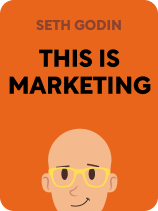

This article is an excerpt from the Shortform book guide to "This Is Marketing" by Seth Godin. Shortform has the world's best summaries and analyses of books you should be reading.
Like this article? Sign up for a free trial here.
What should you do first—create a product or figure out how to sell it? Why do people buy products?
Everyone has problems, needs, and desires. Entrepreneur and marketing expert Seth Godin says that effective business people know how to tap into those—creating products that solve customers’ problems and fill their wants and needs.
Keep reading to learn why Godin promotes problem-solving marketing.
Create Something of Value
To be an effective marketer, you must first create something of value. Godin explains that many people make the mistake of creating a product and then trying to figure out how to sell it. Effective marketers do the opposite: They identify a group of people with a problem and then provide a solution to that problem. In other words, they practice problem-solving marketing.
(Shortform note: In Purple Cow, Godin goes further, arguing that you don’t just need to create something of value, but you also need to create something truly remarkable and unique. Godin argues that it’s a losing battle to try to market a better version of another product; instead, you need to create something new that will stand out from the crowd—the way a purple cow would stand out from a herd of regular cows.)
Godin argues that, to create a product that solves a problem, you should identify an unmet desire or need and make sure that your product addresses it. Godin suggests that people’s needs are often rooted in unmet emotional desires. People don’t buy a product for the product’s sake but for the feeling the product gives them. For example, no one needs a nose hair trimmer or a new set of headphones. But, people do need the self-confidence or social status that those products give them.
(Shortform note: The purchasing decisions we make based on our emotional needs are often unconscious. Some research suggests as much as 95% of our purchasing choices are unconscious. In Thinking, Fast and Slow, psychologist Daniel Kahneman explains our brain has two systems—System 1, which operates automatically with little to no effort; and System 2, which allocates attention to more effortful decision-making. System 2 requires a large input of energy to function, so the majority of our decisions, including our purchasing decisions, happen unconsciously using System 1.)
Godin suggests that most people, regardless of age, gender, or geography, are driven by the same basic human needs, things like safety, security, belonging, or respect. Godin argues that these desires are universal and apply to people from all walks of life but look different depending on whom you’re speaking to. For one person, security might mean a high-quality life insurance policy, while for another it’s an in-home video surveillance system or a paid-off mortgage. By understanding people’s most basic emotional needs, marketers can create products and services that meet those desires, and, by doing so, offer them a solution to their problem.
(Shortform note: Marketing expert Bryan Kramer suggests that there are only six basic human needs: certainty, variety, significance, connection, growth, and contribution. In Human to Human, Kramer argues that marketers who focus on meeting these six needs will be more successful in connecting with their target audiences.)
Exercise: Create Something of Value
Godin argues that, to be an effective marketer, you must first create something of value. He cautions against creating a product and then trying to figure out how to sell it. Instead, he suggests identifying a group of people with a problem and then providing a solution to that problem.
- Who’s your core audience (the person or group of people you’re marketing to)? What are some of the values that are important to them? (Your core audience might be your customer base, but could also be your partner, or friend group, whom you’re trying to sell on an idea.)
- What is a problem that your core audience struggles with?
- Briefly explain how your offering (product, service, or idea) could help solve that problem.

———End of Preview———
Like what you just read? Read the rest of the world's best book summary and analysis of Seth Godin's "This Is Marketing" at Shortform.
Here's what you'll find in our full This Is Marketing summary:
- Why traditional marketing strategies are no longer effective
- Why you should aim to build trust, authenticity, and empathy with customers
- Guiding principles for successful marketing in the modern age






